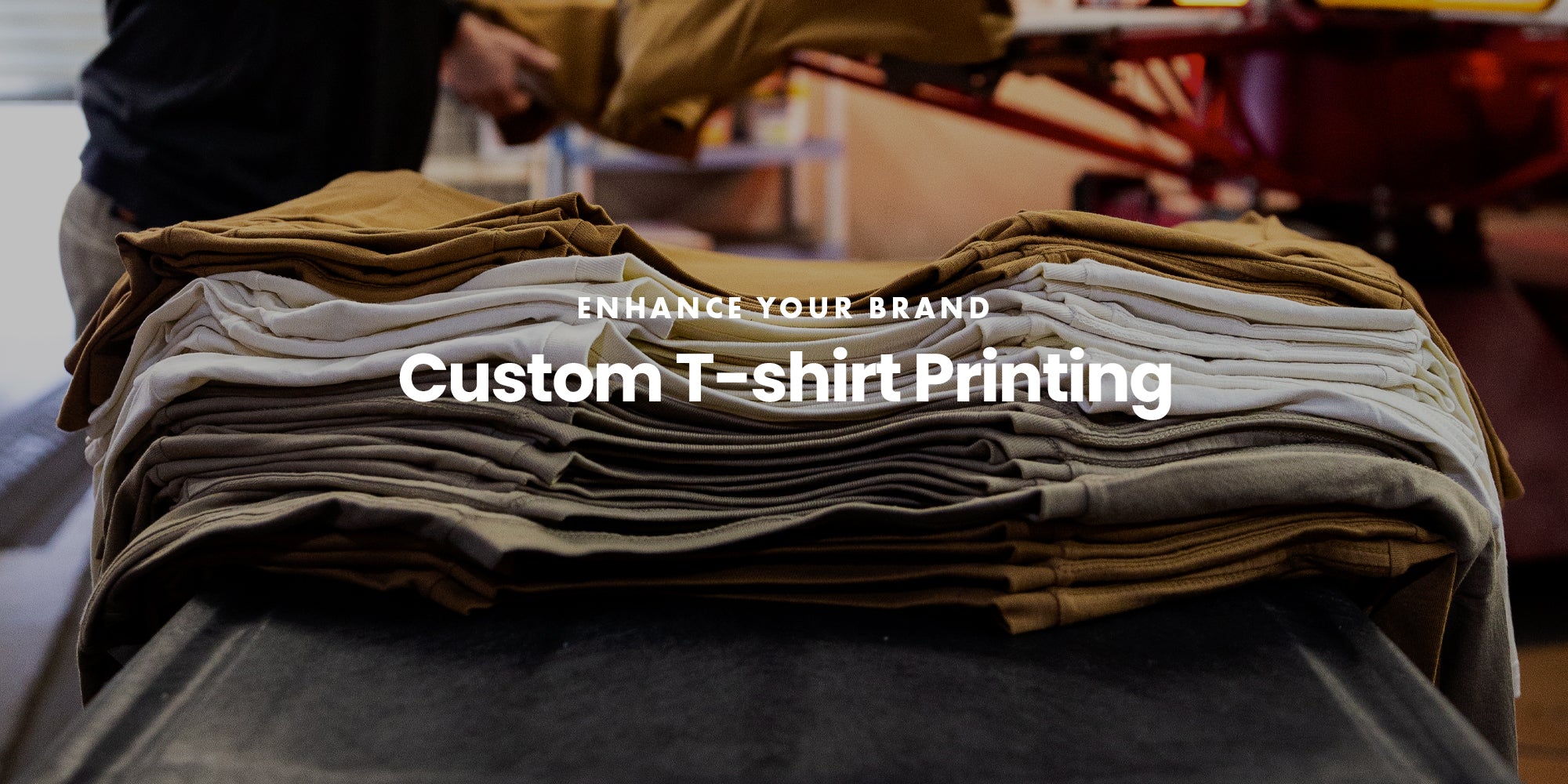Durable T-Shirt Printing for Everyday Wear
Durable T-Shirt Printing for Everyday Wear
Blog Article
Screen Printing Uncovered: Everything You Need to Understand About T-Shirt and Garment Printing Methods
Screen printing is an interesting approach that combines art with technique, supplying unlimited possibilities for imagination. Ready to explore the necessary elements that make screen printing an art form?
The Basics of Display Printing: Just How It Functions
When you plunge into display printing, you'll uncover it's both a scientific research and an art. At its core, display printing involves creating a pattern, or screen, that permits ink to travel through only in particular areas (screen printing kit). You begin by picking your style and preparing your screen with a light-sensitive emulsion. Once you expose this solution to light, it sets, leaving your design as an adverse area.
Setting the display over the fabric, then utilize a squeegee to press ink through the display onto the garment. Each action is crucial, and grasping them will certainly raise your screen printing skills, changing simple garments right into distinct, expressive items.
Kinds Of Display Printing Strategies
When you understand the basics of screen printing, it's time to explore the various strategies that can raise your designs. One popular technique is traditional screen printing, where ink is pushed via a stenciled screen. This technique is great for strong, vibrant shades. Then there's water-based ink printing, which supplies a softer feel and is environmentally friendly, yet it requires a different method to treating.
If you're going for fine details, think about discharge printing. This strategy gets rid of dye from the material, leaving a soft, classic look. Another choice is plastisol printing, known for its longevity and brilliant shades, making it a favorite for lots of brands. Finally, try out halftone printing to develop gradient results and detailed layouts. Each technique has its special appeal, so don't be reluctant to try them out to discover what fits your design best!
Essential Devices for Screen Printing
To accomplish sensational results in display printing, having the best tools is essential. You'll require a strong display printing frame, which holds the mesh that transfers your layout onto the garment. Next, invest in top notch mops; these are necessary for applying ink evenly across the screen.
Picking the Right Inks and Materials
When picking inks and products for display printing, you require to think about the kind of ink that functions best for your project. Assume about fabric compatibility to ensure your styles look terrific and last long. Discover green ink alternatives to make your printing process much more lasting.
Kinds Of Screen Inks
Selecting the right screen ink is vital for accomplishing vivid, resilient prints that meet your job's requirements. There are numerous types of screen inks to take a look at. Specialty inks, such as metal or glow-in-the-dark, can include distinct impacts to your styles.

Material Compatibility Factors To Consider
Recognizing textile compatibility is vital for achieving top notch display prints, specifically because different products respond distinctively to numerous inks. When picking inks, take into consideration the material type-- cotton, polyester, or blends. For cotton, water-based inks function well, supplying soft qualities and breathability. Polyester, on the various other hand, typically calls for plastisol inks for much better adhesion and lively shades. If you're printing on blends, you could need to use a combination of both kinds. Always check your inks on example material to ensure they adhere effectively and preserve color honesty. Furthermore, remember that textile weight and appearance can impact the final outcome, so picking the appropriate ink and material combo is crucial for your job's success.
Eco-Friendly Ink Options
Eco-friendly inks are becoming a preferred choice for display printers who wish to lessen their environmental impact while preserving top quality. When picking inks, think about water-based inks, which are less harmful and simpler to tidy up compared to conventional solvents. These inks bond well with fabrics, providing lively outcomes without toxic chemicals. You may also explore eco-solvent inks that utilize fewer unpredictable organic substances (VOCs), making them a safer alternative for both your health and the world.
In addition, seek inks made from eco-friendly sources, such as soy or vegetable-based alternatives. By choosing the ideal inks and products, you'll not just develop magnificent designs yet likewise add to an extra lasting printing procedure. Make the button, and your prints will reflect your commitment to the setting!
Preparing Your Style for Screen Printing

File Format Demands
To guarantee your style looks dynamic and sharp on material, you'll need to pay close attention to file format needs for display printing. Begin with vector data like AI or EPS, as they can be scaled without losing quality. If you use raster images, select high-resolution data, such as TIFF or PNG, ideally at 300 DPI. Stay clear of using JPEGs, as they can lose clearness when resized. Additionally, make sure your style has a clear history to avoid unwanted white sides on your prints. Keep color modes in mind; CMYK is basic for display printing, so transform your RGB designs appropriately - screen printing kit. By adhering to these standards, you'll set your art work up for an effective print.
Color Splitting Up Strategies
Color splitting up is a necessary step in preparing your layout for display printing, and mastering it can substantially enhance your print high quality. You'll need to break your design into private shades, as each color requires a separate display throughout printing. more information This accuracy not just assures exact color representation yet additionally streamlines the printing procedure.
Resolution and Size
Achieving the most effective cause display printing begins with guaranteeing your design has the ideal resolution and dimension. Preferably, your art work needs to go to least 300 DPI (dots per inch) for sharp, clear prints. Your last item might look pixelated and amateur. if you make use of lower resolution.
When it involves dimension, consider the measurements of your print area. Style your art work to match the final print dimension, ideally creating it in the real measurements you'll be publishing. This means, you'll stay clear of any type of unexpected scaling concerns.
Always check your design in both vector and raster layouts. Vector graphics can be scaled without losing top quality, making them perfect for screen printing. Preparing appropriately will ensure your design looks fantastic on every garment!
Step-by-Step Display Printing Process
Screen printing is a vibrant procedure that permits you to develop dynamic designs on various surface areas. To get going, you'll require a display, solution, and your picked ink. Prepare your screen by cleansing it completely. Next, apply the solution equally and let it dry in a dark area. When dry, reveal your screen to light with your layout positioned on it, which will certainly solidify the solution where the light hits, creating a pattern - screen printing kit.
After rinsing the unexposed emulsion, your screen is all set. my link Set it up on your printing surface area and align your garment beneath it. Put ink onto the screen and use a squeegee to press the ink through the stencil onto the fabric. Lift the screen meticulously and allow the print dry. Cure the ink utilizing warmth to assure toughness. That's it! You've efficiently display printed your layout.
Tips for Successful Screen Printing Projects
While you're diving into your display printing projects, bear in mind that prep work is crucial to success. Start by collecting all your products-- inks, screens, mops, and garments. A tidy office aids stop unwanted errors, so clean up before you start.
Next, validate your artwork is high-resolution and appropriately sized for your garment. Check your screen for correct exposure and clean it thoroughly to stay clear of smudges. When blending your inks, comply with the supplier's guidelines to achieve the right uniformity.
During printing, apply also stress with your squeegee for regular outcomes. Do not rush; take your time to verify each print meets your criteria. After printing, allow your garments completely dry totally prior to handling or packaging them.
Last but not least, constantly maintain an example of your help future reference. By doing this, you can evaluate your progression and boost your strategies with time. Delighted printing!

Frequently Asked Concerns
For how long Does It Require To Establish up a Screen Printing Task?
Establishing up a screen printing work usually takes about 30 minutes to an hour. You'll prepare the screens, mix inks, and change journalism. The time varies based on complexity and experience, so stay organized!
Can I Publish on Various Textile Keys In Using the Exact Same Strategy?
Yes, you can publish on various textile types utilizing the exact same strategy, but you'll need to readjust your inks and setups. Some fabrics take in ink differently, so trying out warranties the best resource results for each material.
What Prevail Mistakes to Avoid in Display Printing?
When display printing, stay clear of usual blunders like using the wrong ink, overlooking appropriate direct exposure times, or skipping pre-press checks. Constantly evaluate your configuration and maintain tidy screens to guarantee top quality outcomes each time.
Exactly How Can I Properly Clean and Keep My Screen Printing Tools?
To correctly clean and preserve your screen printing tools, you ought to routinely wash screens with appropriate solvents, check squeegees for wear, and guarantee all tools are stored dust-free and completely dry. Uniformity avoids pricey repair work and boosts performance.
Is Display Printing Eco Friendly Compared to Other Methods?
Display printing can be a lot more eco pleasant than various other methods, especially if you utilize water-based inks and eco-conscious materials. By selecting lasting materials and techniques, you reduce waste and decrease your impact on the earth.
Display Printing Uncovered: Whatever You Need to Know About Tee and Garment Printing Methods
At its core, display printing entails producing a stencil, or display, that permits ink to pass with just in specific areas. Position the screen over the fabric, then make use of a squeegee to push ink with the display onto the garment. One prominent method is typical display printing, where ink is pushed via a stenciled screen.When picking inks and materials for screen printing, you require to take into account the type of ink that works finest for your project.
Report this page